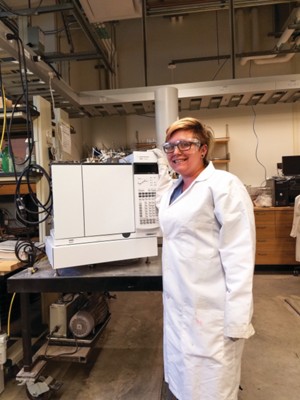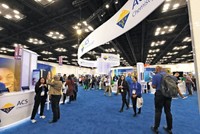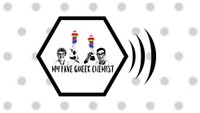Advertisement
Grab your lab coat. Let's get started
Welcome!
Welcome!
Create an account below to get 6 C&EN articles per month, receive newsletters and more - all free.
It seems this is your first time logging in online. Please enter the following information to continue.
As an ACS member you automatically get access to this site. All we need is few more details to create your reading experience.
Not you? Sign in with a different account.
Not you? Sign in with a different account.
ERROR 1
ERROR 1
ERROR 2
ERROR 2
ERROR 2
ERROR 2
ERROR 2
Password and Confirm password must match.
If you have an ACS member number, please enter it here so we can link this account to your membership. (optional)
ERROR 2
ACS values your privacy. By submitting your information, you are gaining access to C&EN and subscribing to our weekly newsletter. We use the information you provide to make your reading experience better, and we will never sell your data to third party members.
Careers
LGBT chemists seek a place at the bench
Lesbian and gay chemists find workplaces more welcoming, transgender researchers seek greater inclusion
by Linda Wang
October 17, 2016
| A version of this story appeared in
Volume 94, Issue 41

“Some grad students won’t use the bathroom when I’m in there, and they won’t invite me to social events all of a sudden.”
—Carolyn Hutchinson, a chemistry Ph.D. student at Iowa State University
Nine months pregnant, Kyle F. Trenshaw recently grappled with what to wear to a job interview. “Here I am, trans dude, super pregnant, and they want me to come in for a job interview,” says Trenshaw, a postdoc in science, technology, engineering, and mathematics (STEM) education at Brown University who is in the process of transitioning from female to male.
“I was like, ‘What the heck do I wear?’ ” He opted for a button-down shirt, elastic waist khaki pants, nice shoes, and a tie.
Trenshaw could never have imagined such a scenario a few years ago when he was a closeted graduate student struggling with his identity. “I felt like maybe queer people shouldn’t be in science,” he says, using a once-derogatory word now often used as an overarching term that encompasses the lesbian, gay, bisexual, and transgender (LGBT) community.
Depression and isolation led to thoughts about ending his life.
Recent progress such as the legalization of same-sex marriage in the U.S., a growing awareness of LGBT issues, and more state protections against being fired for sexual orientation and gender identity has helped more LGBT chemists feel safe in coming out and has empowered them with the conviction that they deserve a place at the bench.
“In the equality movement, we’ve gotten the door open, gotten ourselves at the table, and have conditioned younger people to expect equal treatment,” says Barbara Belmont. She’s one of the early leaders of the American Chemical Society Division of Professional Relations (PROF) Gay & Transgender Chemists & Allies Subdivision.
Part of the effort to create a more inclusive workplace involves understanding what LGBT chemists experience on the job. The National Science Foundation is funding a three-year effort called the STEM Inclusion Study to delve into the experiences of underrepresented and marginalized communities in the STEM workforce.
“I think that recognition of the LGBT workplace equality movement has been going on for a long time in other fields, and some STEM fields have been lagging behind,” says Tom Waidzunas, a sociologist at Temple University and a principal investigator on the study. “Our goal is to try to understand the mechanisms of exclusion or the mechanisms of disadvantage for LGBT folks in STEM. If they exist, what are the reasons why LGBT folks might face barriers to promotion or face adversity on the job, and how do they navigate these challenges?”
Another ongoing study is called Queer in STEM, a nationwide survey to learn about LGBT experiences in scientific and technical careers.
“Queer individuals are currently underrepresented in STEM careers,” says Daniel Cruz-Ramirez de Arellano, a chemistry instructor at the University of South Florida and one of the study’s leaders. “We are hoping to show the world that queer individuals are active and productive in STEM careers.
“Hopefully, the newer generation can feel inspired and say, ‘There is a place for me in STEM even though I am queer.’ ”
In June, C&EN conducted an informal poll of its readers to look more closely at the experiences of LGBT individuals in the chemistry community. Of the 270 who responded, 70% said that they are out about their sexual orientation or gender at work; 79% indicated that their workplace has a policy to prevent discrimination based on sexual orientation; 13% said they had felt excluded, intimidated, or harassed at work within the past year; and 44% said they had felt this in the course of their career.
The degree to which LGBT chemists feel protected on the job partly depends on where they live. Only 20 states and the District of Columbia prohibit discrimination based on sexual orientation and gender identity.
“In those states where it’s not safe, if you lose your job because you are LGBT, you can’t sue for discrimination,” Belmont says.
A chemist in Cary, N.C., tells C&EN that when the state passed a law that bars local municipalities from creating their own rules prohibiting discrimination in public places based on sexual orientation and gender identity, it felt like a “stab in the back.” That’s even though his company has a nondiscrimination policy.
“The psychological impact of the state saying you’re now less than a human is pretty huge,” says the man, who asked that his name not be used in this article to protect his job prospects. “If I was looking for a new job, I would have to look even harder to make sure I was protected and that I couldn’t be fired for being gay.”

“It’s not a surprise to find that you might have LGBT employees applying for your positions or working around you.”
—Kirk Nass (left), a team leader at Chevron, with his husband on their wedding day
Many LGBT chemists say they won’t attend scientific meetings in a state that doesn’t offer them protections. “I would never go to a conference now in Arkansas, Tennessee, or North Carolina because I would not be able to go to the bathroom without fear that I would be fined or go to jail,” says Trenshaw, the postdoc at Brown.
ACS’s 2017 Southeastern Regional Meeting (SERMACS) is planned for Charlotte, N.C. Linette Watkins, SERMACS board chair, says the board grappled with whether to hold the meeting there, move it to a different location, or cancel it altogether. Because the local section would lose years of effort it put into organizing the conference, the board decided to keep the meeting in North Carolina.
“This was a no-win situation, but we can use this opportunity to call attention to LGBT issues and discuss ways to prevent this in the future,” says Watkins, who points to plans for a half-day symposium on inclusion during the meeting.
Despite the variation in state-specific laws, LGBT chemists say they are much more comfortable than ever before talking about their personal lives at work.
When Kirk Nass started at Chevron in 1989, he put a photo of his partner and himself on his desk.
“People came in and would go, ‘Is that your brother?’ and I’d have to say, ‘Well, no, he’s my partner,’ ” Nass remembers. “You never knew what kind of reaction you would get.”
Now a manager at Chevron, Nass has on his desk that same photo, a more recent photo of him and his partner on their wedding day, and a photo of their grandson. “It’s just not a surprise anymore,” he says.
Roland Dunbrack Jr. remembers how threatened he felt in graduate school when a few undergraduate students called him a “faggot” and other homophobic slurs when they saw him holding hands with his boyfriend. Now a tenured professor of molecular therapeutics at Fox Chase Cancer Center in Philadelphia, Dunbrack says he is out and proud at work and feels fully supported by his colleagues.
Recently, he invited his research group to one of his performances in the Philadelphia Voices of Pride, an LGBT community chorus. Nearly the entire group attended.
“I was really moved by my students being there,” he says. “Ten years ago, I wouldn’t have asked them. It makes me a complete human being when I can talk about the chorus and my friends without feeling like I have to hide the fact that I have a social life.”
T. J. Ronningen, a scientist at Battelle, is encouraged to see his company’s leaders attend events organized by the firm’s LGBT employee resource group. “Over the past 10 years, I’ve seen a lot more employees willing to do things like encourage staff to participate in Pride events and directly acknowledge Pride Month in June,” Ronningen says. “That’s certainly very encouraging and promotes a message of inclusion.”

“Transition has helped me think more about the kinds of work that I do as a chemist and as a member of the chemistry community, and I think that line of inquiry is never going to end.”
—Nancy Williams, an associate professor at Claremont McKenna, Pitzer, and Scripps Colleges
Changing attitudes are helping trans individuals come out as well. Nancy S. B. Williams is an associate professor of chemistry at the W. M. Keck Science Department of Claremont McKenna, Pitzer, and Scripps Colleges. She says that after she received tenure and began coming out as a trans woman in 2012, it meant the world to her that her boss and colleagues were supportive. “My supervisor said, ‘I’ve got your back,’ and that was really important.”
In the past, “it seemed impossible to come out. There was no question in my mind that there was no way I could be a chemist and be trans,” she says. “I repressed it, as many trans people do, for a very long time, and just pushed those feelings down and hid them even from myself, and I buried myself in my work. It does an enormous amount of damage over time.”
Marginalization remains an issue among the trans community. Carolyn Hutchinson, a sixth-year chemistry Ph.D. student at Iowa State University, remembers being shunned by peers after coming out a year and a half ago as nonbinary—which refers to someone who identifies neither as strictly male nor strictly female. “Some grad students won’t use the bathroom when I’m in there, and they won’t invite me to social events all of a sudden,” Hutchinson says.
However, Hutchinson says the faculty members have been supportive. “There’s no difference in how they treated me before and after I’ve come out. They very much want me to be the best student I can be, the best chemist I can be, and the best teacher I can be, and I appreciate that.”
At another U.S. university, a chemistry graduate student who is in the process of transitioning from male to female is considering whether to come out to her research group. “After a year of being relatively depressed and not really knowing what I should do, I decided that if this is going to make me happy and be more productive and a better individual, I should just go forward with it,” she says.
However, a neutral reaction from her adviser has made this student question whether to come out to the rest of the lab. “I’m still stuck in limbo,” says the woman, who asked that her name not be used. As for her impending job search, “I would love it if I could come out of the closet, quietly close the door behind me, and then proceed to interact with the rest of the society completely normally.”
Yet that’s not the case for most trans individuals looking for jobs. Williams, the Claremont McKenna, Pitzer, and Scripps Colleges associate professor, says that with publications and transcripts under a previous name, and potentially revealing medical records and background checks, “there is almost no way to avoid being outed in the hiring process.
“It is exceptionally important that we have hiring processes that respect that privacy,” she continues. “We need an environment where the candidate actively wants to come out in their application and say, ‘This is one of the things I’m going to bring to your institution,’ ” rather than trying to cover up their past.
Trenshaw says that he is looking for a job in a place where being trans will be considered an asset. So he’s looking for positions in academic advising where he can help other marginalized students in STEM.
Although he didn’t get the position he had interviewed for, Trenshaw says he’s grateful for the support and flexibility he received from the interviewers and hopes other potential employers will be similarly understanding.
“Being trans is very limiting, not just because of what people may do to you,” he says. Uncertainties abound. “Are these people going to be okay with me? Will this institution be supportive, can I live in this state, will someone sell me a house?”
Resources such as the Human Rights Campaign’s Corporate Equality Index can help point LGBT chemists to more inclusive companies, and the Campus Pride Index helps students find schools that are LGBT-friendly.
“One of your best bets might be to look at institutions that have thriving, out LGBT chemists,” Williams says. “That’s probably a better place for you to think about being out and trans, and you’re probably more likely to look at places that have good policies already on the books and a corporate nondiscrimination policy that includes gender identity and expression.”

Source: Human Rights Campaign
Williams recommends that employers prepare for a trans individual long before the first one shows up.
“Because we haven’t thought about these things very often in the workplace, the trans person immediately gets viewed as a complication and a source of worry, and it just becomes that much easier to look at the next person’s résumé or CV,” Williams says. “When we talk about diversity in hiring and diversity in the workplace, we need to be openly talking about out LGBT status and out trans status as something we see as part of the diversity that we value in our chemical workplace.”
Advertisement
Additional resources for LGBT chemists are available through the National Organization of Gay & Lesbian Scientists & Technical Professionals (an ACS diversity partner) and the ACS PROF Gay & Transgender Chemists & Allies Subdivision.
The subdivision is organizing its first LGBT Graduate & Postdoctoral Student Chemistry Research Symposium at the ACS national meeting in San Francisco in early 2017. It sponsored a Safe Zone workshop at the recent ACS national meeting in Philadelphia. A Safe Zone is a designated place where all people are welcomed and included. These workshops help foster such spaces on campuses and in workplaces.
Stephanie Farrell is a professor at Rowan University and principal investigator on an NSF grant to conduct Safe Zone workshops at professional society conferences. She says those who support LGBT scientists are often quiet. “If you can do something to be visible and let people know you’re an ally, it really means a lot and it can help effect change,” Farrell says. As examples, she suggests supporters attend a couple of LGBT student events and sport a Safe Zone sticker on their office or lab door, phone, or laptop.
Ultimately, LGBT scientists simply want a place at the bench.
“Don’t make assumptions about people,” says Hutchinson, the Ph.D. student at Iowa State. “You don’t know anything about anyone until you get to know them.” She adds, “If you’re in chemistry, at the end of the day everyone’s a chemist, and you’ll always have that in common.”





Join the conversation
Contact the reporter
Submit a Letter to the Editor for publication
Engage with us on Twitter